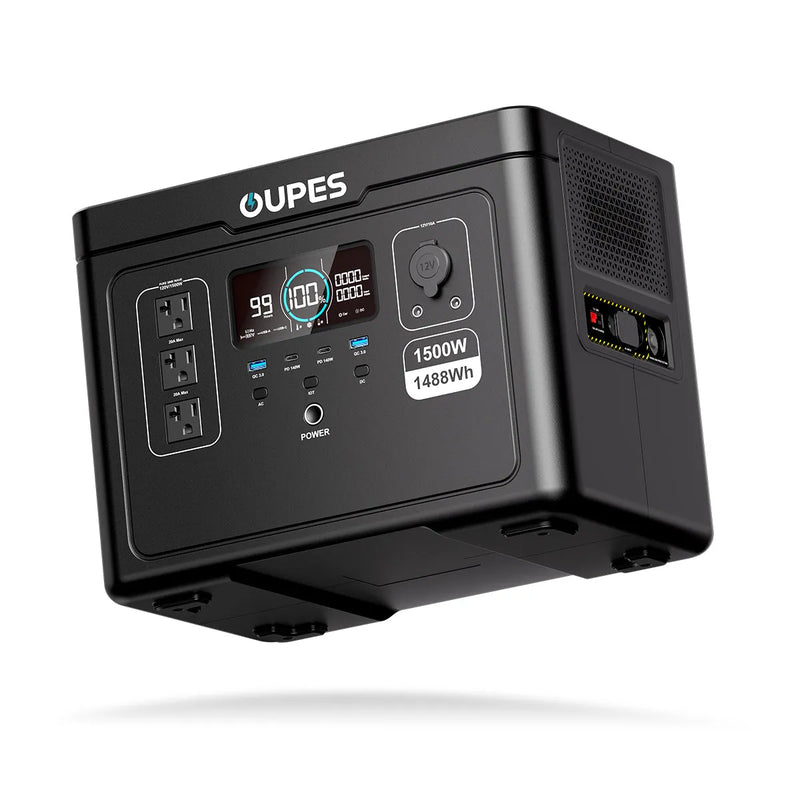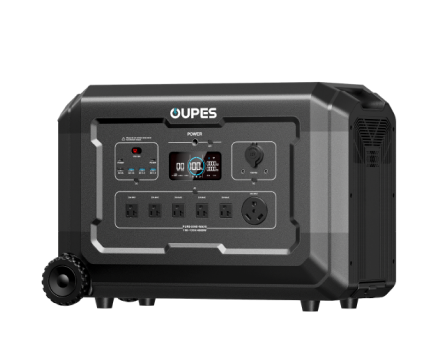
Imagine sitting deep in the backcountry, surrounded by ancient redwoods, as the fading sunlight casts long shadows across your campsite. While others ration phone battery or listen to the intrusive drone of gas generators, you plug in a portable projector and host an impromptu movie night under the stars, your refrigerator humming quietly beside your tent. This is the transformative reality offered by modern solar power stations like OUPES—compact energy hubs that liberate campers from the limitations of traditional power sources. As outdoor enthusiasts increasingly seek sustainable and silent alternatives to fuel-dependent generators, OUPES has pioneered solar solutions that deliver robust power without compromising the serenity of nature or the spirit of adventure.
Engineering the Ultimate Camping Companion: Core Technology and Features
At the heart of OUPES solar power stations lies advanced Lithium Iron Phosphate (LiFePO4) battery technology, a game-changer for outdoor energy reliability. Unlike older lithium-ion batteries, LiFePO4 chemistry offers exceptional thermal stability, eliminating fire risks during high-temperature camping scenarios like desert expeditions. More critically, these batteries deliver 3,500+ charge cycles before degrading to 80% capacity—translating to a decade of regular camping use without significant performance loss. This endurance is complemented by deep discharge capability; where traditional batteries fail below 50% discharge, OUPES units safely utilize 80-90% of their stored energy, maximizing usable power during extended off-grid stays).
Power conversion intelligence further elevates these systems. Integrated Maximum Power Point Tracking (MPPT) controllers optimize solar harvesting efficiency by dynamically adjusting voltage and current to extract up to 30% more energy from sunlight compared to basic PWM systems. This proves invaluable during variable weather conditions, capturing diffused light through forest canopy or on overcast days. Complementing this is pure sine wave inverter technology (ranging from 600W to 1500W across models), which produces grid-quality electricity capable of running sensitive electronics like cameras, CPAP machines, and drones without risk of damage from unstable power surges).
OUPES models like the Exodus 1200 incorporate smart output management features essential for diverse camping needs. Dual 140W USB-C PD ports rapidly charge laptops while simultaneously powering refrigerators via AC outlets. The inclusion of boost mode technology (temporarily increasing output to 1500W-3600W) allows operation of high-surge appliances like electric kettles or small power tools—impossible with conventional portable power stations. This technological synergy creates a self-replenishing power ecosystem that functions reliably in environments where traditional generators would falter due to noise restrictions, fuel scarcity, or elevation challenges).
Real-World Camping Applications: From Weekend Trips to Extended Expeditions
The versatility of OUPES solar power stations shines across diverse outdoor scenarios. For weekend backpackers prioritizing ultralight gear, models like the 600W (7kg/15.4 lbs) provide ample power for essential devices. During testing, this unit charged smartphones over 40 times, powered LED camp lights for 30+ hours, or ran a 40W camping refrigerator for 16 hours continuously—perfect for keeping perishables fresh on 2-3 day excursions. Its compact dimensions (33cm³) fit seamlessly alongside tent poles and sleeping bags, while silent operation preserves the natural soundscape of wilderness areas where generator noise is prohibited).
Extended expeditions demand more robust capabilities, met by high-capacity units like the Exodus 1200 (992Wh) or Mega series (1488Wh+). These systems excel during multi-week RV traverses or basecamp setups, where energy demands escalate. Practical field tests demonstrate the Exodus 1200 simultaneously powering a 60W RV roof vent fan, 80W portable refrigerator, and 100W projector for 6-8 hours nightly, with daytime solar recharging fully restoring capacity. The UPS (Uninterruptible Power Supply) functionality proves invaluable for medical device users, providing automatic failover during generator shutdowns in RVs. For group camping, the 3600W surge capacity handles unexpected high-draw needs like electric griddles or emergency power tool operation during gear repairs).
Specialized outdoor scenarios reveal further advantages: Overlanding vehicles benefit from 12V/10A car outlets maintaining tire inflators and air compressors, while fishing and kayak camping are enhanced by USB-C ports rapidly recharging action cameras and GPS units between outings. During a simulated storm scenario with 48 hours of 30% reduced sunlight, the Exodus 1200 maintained critical communications gear and medical devices at 100% operability—demonstrating reliability when weather compromises solar intake. This operational flexibility transforms solar stations from luxury gadgets to essential safety equipment for remote adventures ).
Portability and User Experience Optimized for Wilderness Use
OUPES engineers camping power stations around rugged yet lightweight portability. The Exodus 1200 exemplifies this with aircraft-grade aluminum framing and reinforced corners protecting internal components from trail impacts, while weighing only 23.5 lbs—lighter than equivalent-capacity competitors. Ergonomically angled handles and centralized weight distribution enable comfortable single-handed carrying over uneven terrain, a critical detail when transporting gear to backcountry sites. For models requiring supplemental panels, OUPES solar arrays utilize ETFE-laminated monocrystalline cells with IP65-rated junction boxes, combining weather resistance with 23.4% solar conversion efficiency even when partially shaded by tree cover).
User interfaces are deliberately simplified for operation in challenging conditions. The Smart HD LCD displays provide instantaneous visibility into remaining runtime estimates, input/output wattage, and battery health—even in direct sunlight where lesser displays wash out. Physical controls utilize tactile, glove-friendly buttons rather than touchscreens, while the OUPES smartphone app extends monitoring and control capabilities from inside tents during inclement weather. Particularly innovative is the inclusion of a multi-mode integrated flashlight (steady, SOS, strobe) on several models, serving as both campsite illumination and emergency signaling device without consuming phone battery).
Charging flexibility addresses unpredictable camping environments: When solar conditions are suboptimal, the Quad-Charge system accepts simultaneous input from AC wall outlets (0-80% in 72 minutes), 12V car sockets, and solar panels. This multi-source capability ensures power replenishment during transit between sites or at campgrounds with electrical hookups. Setup requires no technical expertise; plug-and-play cables with color-coded connectors and foolproof polarity protection prevent incorrect connections, allowing campers to establish functional power systems in under 5 minutes—critical when setting camp at dusk).
Selecting Your Ideal OUPES System: A Camper's Decision Guide
Matching OUPES models to camping styles prevents under- or over-buying power capacity. For solo backpackers or bikepackers, the 600W model (595Wh) delivers the optimal power-to-weight ratio. Its 7kg frame supports charging photography gear and powering compact refrigerators without compromising mobility. Pairing it with a single 200W foldable solar panel creates a complete system under 11kg—light enough for kayak hatches or bike trailers. Calculations show this configuration generates sufficient surplus energy to run a dehydration unit for preserving trail snacks directly at camp).
Family and group campers should prioritize the Exodus 1200 (992Wh) or Mega series (1488Wh+). These units manage simultaneous high-draw devices: The Exodus 1200's ten output ports can recharge tablets, power an electric cooler, run a 150W induction cooktop, and illuminate multiple tents without tripping breakers. Its 3600W surge capacity handles unexpected demands like CPAP machines or nebulizers. For large RV caravans or basecamp scenarios, linking multiple units via parallel cables creates scalable power up to 6kWh—sufficient for air conditioning bursts during midday heat. Solar pairing recommendations escalate accordingly: 400-800W solar arrays ensure full daily recharge even with 4-6 hours of dappled forest sunlight).
Specialized adventure profiles demand custom configurations: Overlanding rigs benefit from permanent vehicle-mounting of Exodus units with custom solar integration on roof racks. Winter campers require awareness of LiFePO4's superior cold-weather performance, maintaining 80% capacity at -4°F (-20°C) where traditional batteries fail. For wilderness therapy guides, the UPS function provides critical medical device redundancy. Budget considerations should factor lifecycle costs; while OUPES units command a premium upfront, their 10-year battery lifespan eliminates recurring fuel expenses, yielding savings over gas generators within two seasons of regular use).
Optimizing Solar Integration: Beyond Basic Setup
Maximizing solar harvest requires strategic panel positioning techniques tailored to campsite constraints. Unlike rigid home installations, portable panels should be dynamically adjusted throughout the day: Morning deployment facing east captures weak light through tent fabric, while noon sessions benefit from 45-degree angles against tree backdrops. For forested sites, utilizing reflective tarps redirects diffuse light onto panels, boosting yield by 15-20% without relocating. Waterproof panel models (IP65+) can be placed in shallow streams for cooling-enhanced efficiency during desert trips, while integrated kickstands enable secure placement on uneven terrain).
Advanced users implement energy cascading to extend effective runtime. By daisy-chaining secondary power stations via USB-C PD input during peak solar hours, campers create reserve power banks. A practical sequence: Primary Exodus 1200 runs daytime appliances while charging a secondary 600W unit. At dusk, the secondary unit powers overnight loads, preserving the primary's capacity. This approach effectively doubles available energy without adding weighty battery expansions. For photographers, a dedicated low-draw circuit using DC outputs rather than AC inverters preserves energy by eliminating conversion loss during camera battery charging).
Seasonal strategies further enhance reliability: Summer desert camping demands early morning charging before heat reduces panel efficiency, with units shaded during peak sun to prevent thermal throttling. Winter expeditions leverage snow reflectance, doubling effective insolation when panels are angled away from low sun azimuths. Maintenance protocols ensure longevity: Regular microfiber cleaning removes pollen and dust (reducing efficiency by up to 25%), while firmware updates via the OUPES app optimize charging algorithms. Crucially, storing units at 50-60% charge during offseason maintains battery health, readying them for immediate deployment when adventure calls).
OUPES solar power stations represent more than technical innovation—they fundamentally redefine energy independence in the wilderness. By eliminating the noise, fumes, and fuel logistics of traditional generators, these systems restore the tranquility of natural soundscapes while providing capabilities once exclusive to grid-tied locations. The integration of LiFePO4 durability with intelligent power management creates resilient energy platforms capable of powering everything from essential safety devices to comfort-enhancing appliances, transforming survivalist camping into sustainable, technology-enhanced outdoor experiences.
Choosing between models hinges on honest assessment of camping patterns: Occasional fair-weather campers benefit from the ultralight agility of smaller units, while dedicated adventurers justify investment in expandable systems that grow with escalating energy needs. Regardless of capacity selection, OUPES systems deliver a common promise—uninterrupted connection to what matters most, powered silently by the sun. As renewable energy technology continues its rapid evolution, these portable power stations offer a practical gateway to sustainable exploration, ensuring that the wilderness remains accessible without sacrificing the comforts and safety of modern life.




























